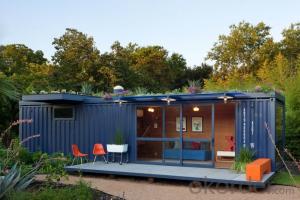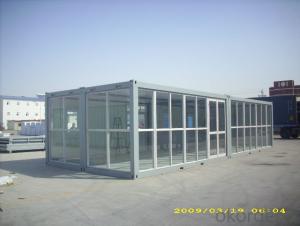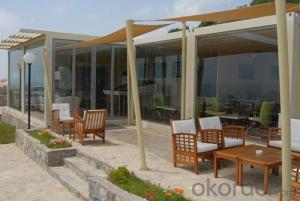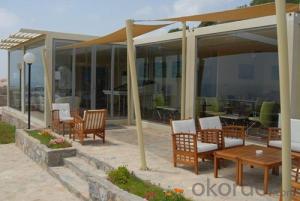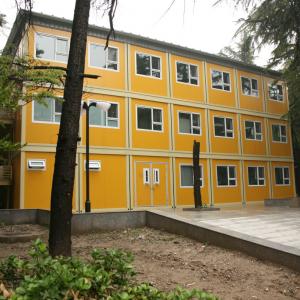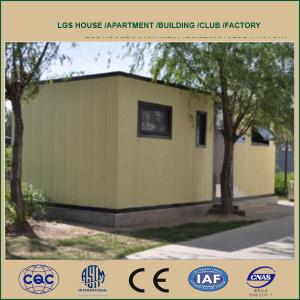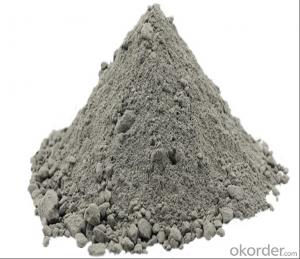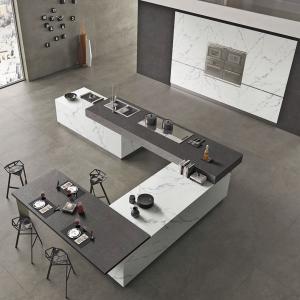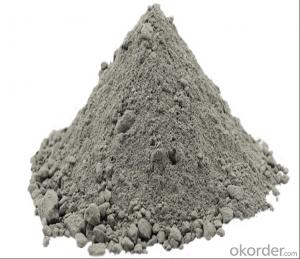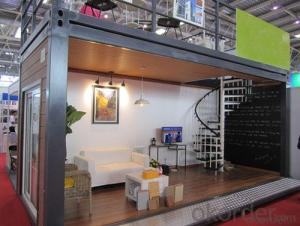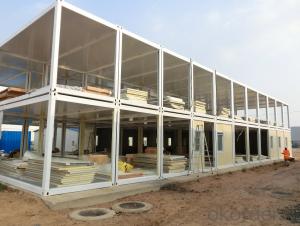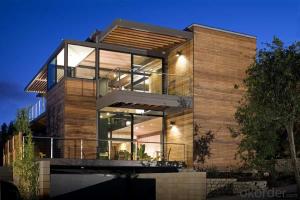China 20ft and 40ft shipping container houses prefabricated modular housing
- Loading Port:
- China Main Port
- Payment Terms:
- TT OR LC
- Min Order Qty:
- -
- Supply Capability:
- -
OKorder Service Pledge
OKorder Financial Service
You Might Also Like
Specifications
1low cost modular house. low cost
2. easy installation
3 Green and environmental material
4. Power-Saved
Specifications
1. Firm structure and multiple use.
2. Lost cost and convenient in shippment.
CNBM INTERNATIONAL LOW COST PREBUILT CONTAINER HOUSES
Product description
1. Container house is a unit house with the size of 6055mm*2435mm*2740mm.
2. The container house adopts EPS, glass wool or rock wool as heat insulation material.
3. All the components are standard and prefabricated with the advantage of assembling and disassembling easily. Six skilled workers can finish three modular units in 8 hours.
4. 4sets of standard container house can be packed together to replace the shipping space of one 20ft container.
5. The container house can be linked freely at length, width and height through the linking kits for bigger structure and different layout.
6. Waterproof design of galvanized structure, fireproof and heat insulation of material ensure the house to resist heavy wind load of 0.6KN/m2and 8 degree seismic intensity.
7. The life span of the house is 20-25 years.
Characteristics
1. Cost Effectiveness
2. Chemical free, and lower waste
3. Easy to erect
4. Safety
5. Fireproof, termite free
6. Strong and durable – weatherproof, anti-seismic
7. Materials will not shrink, rot or warp
8. Pre-galvanized for rot and corrosion prevention
Benefits of factory built prefabricated houses and villas
| |
Very little maintenance | Reduce environmental pollution and save water |
Ease and speed of erection | Easily transportable |
Aesthetically pleasing | Buildings can be relocated |
Priced more economically than brick | Buildings can be designed by your choice
|
- Q:Can container houses be designed for hurricane-prone areas?
- Yes, container houses can be designed to withstand hurricane-prone areas. By using reinforced steel frames, impact-resistant windows, and additional hurricane-proofing measures such as tie-down systems and wind-resistant roofing materials, container houses can be made resilient against strong winds and potential damage caused by hurricanes. Additionally, proper site selection and construction techniques can further enhance the safety and durability of container houses in hurricane-prone areas.
- Q:Can container houses have traditional interiors?
- Yes, container houses can certainly have traditional interiors. While container houses are often associated with a modern, minimalist aesthetic, they can be designed and furnished in a way that reflects more traditional styles. The key lies in the interior design and the choice of materials, colors, and furnishings. For example, traditional furniture pieces such as wooden tables, classic upholstered chairs, and antique cabinets can be used to create a traditional atmosphere. Additionally, traditional decorative elements like ornate moldings, patterned wallpapers, and chandeliers can be incorporated into the interior design. With the right combination of elements, container houses can be transformed into cozy and charming spaces that exude a traditional style.
- Q:Are container houses suitable for co-living spaces?
- Yes, container houses can be suitable for co-living spaces. Container houses are versatile, cost-effective, and can be easily modified to fit the needs of co-living arrangements. They offer efficient use of space, can be customized to include common areas and private living spaces, and can be stacked or connected to create larger living spaces. Additionally, container houses can be environmentally friendly, as they are often made from recycled materials.
- Q:Can container houses be designed with a tropical or beach theme?
- Certainly, container houses have the potential to be designed with a tropical or beach theme. The extensive flexibility of container homes allows for an infinite array of design options and aesthetics. To achieve a tropical or beach-themed container house, several essential elements can be integrated. To begin, the exterior of the container house can be adorned with lively, tropical hues such as turquoise, coral, or sunny yellow, effectively capturing the essence of the beach theme. Additionally, the inclusion of features like palm trees, tropical plants, or even a small sandy area surrounding the house can enhance the overall tropical ambiance. Within the container house, the design can be further elevated to emanate a tropical or beach atmosphere. This can be accomplished by employing materials like bamboo or driftwood for furniture, flooring, or wall coverings. The incorporation of nautical or beach-inspired decorations, such as seashells, netting, or beach artwork, can also contribute to the overall thematic coherence. Furthermore, incorporating large windows and open floor plans into the design can optimize natural light and establish a seamless connection between the indoor space and the outdoor surroundings. This will allow residents to relish the tropical views and refreshing breeze while inside the container house. In terms of functionality, container houses can be equipped with features that suit tropical or beach environments. For instance, installing an outdoor shower or a small pool can provide a rejuvenating way to cool off in the tropical heat. Prioritizing the use of sustainable and eco-friendly materials can also align the container house with its natural surroundings and promote an environmentally conscious lifestyle. In conclusion, container houses can be designed with a tropical or beach theme by incorporating vibrant colors, natural materials, nautical decor, and functional elements. With thoughtful planning and creative execution, container homes can offer a distinctive and stylish living space that perfectly complements a tropical or beach environment.
- Q:Are container houses suitable for vacation or rental properties?
- Certainly, vacation or rental properties can indeed benefit from the suitability of container houses. The rising popularity of these houses can be attributed to their affordability, sustainability, and versatility, which have captured the attention of many in recent years. As a result, they have become an appealing option for property owners seeking to invest in vacation or rental properties without straining their finances. Moreover, container houses offer numerous advantages for vacation or rental properties. Firstly, their cost-effectiveness is noteworthy. Compared to conventional housing options, containers are readily available and relatively inexpensive. This makes them an attractive selection for property owners aiming to invest in vacation or rental properties without incurring excessive costs. Secondly, container houses boast high customizability. Through innovative design and creative thinking, containers can be transformed into contemporary and chic living spaces. They can effortlessly be modified to include essential amenities such as bedrooms, bathrooms, kitchens, and living areas, ensuring that occupants enjoy a comfortable and delightful stay. Additionally, container houses are eco-friendly. By repurposing shipping containers, we are actively reducing waste and promoting sustainability. Moreover, these houses can be equipped with energy-efficient features like solar panels, rainwater harvesting systems, and proper insulation, further lessening their environmental impact. Furthermore, container houses possess portability, which renders them ideal for vacation or rental properties. Their ability to be easily transported to different locations allows property owners to place them in picturesque areas, near the beach, or in other desirable locations to attract tenants or vacationers. The mobility of container houses also enables property owners to explore various markets and maximize their rental income. Nevertheless, it is crucial to consider the potential limitations of container houses for vacation or rental properties. Limited space may be a constraint compared to traditional houses, affecting the number of occupants that can comfortably stay. Additionally, noise insulation may present a challenge, necessitating the implementation of proper insulation and soundproofing measures. In conclusion, container houses indisputably fulfill the criteria for vacation or rental properties. Their affordability, versatility, and eco-friendliness make them an enticing choice for property owners. With appropriate customization and design, container houses can provide a distinctive and comfortable experience for vacationers or tenants, establishing them as an excellent investment option for those in the hospitality or rental industry.
- Q:What is the advantage of the container module room?
- Activity: Movable, reusable. Quickly set up: the construction period is short, free ground.
- Q:Are container houses suitable for areas with limited access to emergency services?
- Areas with limited access to emergency services may find container houses to be a suitable option, but it is important to consider several factors. Firstly, container houses are designed to be durable and sturdy, as they are made of steel and can withstand extreme weather conditions. They are also resistant to fire, pests, and mold, which adds a level of safety and security in areas where emergency services may be delayed. Moreover, container houses can be customized and equipped with safety features to enhance their suitability for areas with limited emergency services. For instance, installing fire alarms, smoke detectors, and fire extinguishers can reduce the risk of fire. Similarly, incorporating security systems and secure doors can deter potential intruders and provide peace of mind. However, it is crucial to remember that container houses should not be considered a complete replacement for emergency services. While they can offer some level of protection, they cannot replace the immediate assistance provided by trained professionals during emergencies. Hence, individuals residing in areas with limited access to emergency services should have alternative plans in place. This may involve having a well-stocked first aid kit, acquiring basic first aid and emergency response skills, and establishing communication channels with neighbors or nearby communities. In conclusion, container houses can serve as a viable housing solution in areas with limited access to emergency services, but it is crucial to acknowledge their limitations and take proactive measures to ensure personal safety and well-being.
- Q:Can container houses be designed to have a basement?
- Yes, container houses can be designed to have a basement. However, the feasibility of adding a basement to a container house depends on various factors such as the size and condition of the land, structural considerations, and local building regulations. It may require additional planning, engineering, and construction expertise to properly design and implement a basement in a container house.
- Q:Can container houses be designed to have a separate entrance?
- Yes, container houses can definitely be designed to have a separate entrance. The modular nature of container houses allows for flexibility in design, making it possible to create separate entrances based on individual needs and preferences. Architects and designers can incorporate various elements such as additional doors, separate staircases or ramps, or even create separate modules within the container house to accommodate a separate entrance. This allows for better privacy and segregation of living spaces, making it a viable option for those looking for separate entrances in their container house design.
- Q:Are container houses suitable for small business offices?
- Indeed, container houses prove to be a viable choice for small business offices. They present various advantages that render them suitable for such purposes. To start with, container houses offer a cost-effective solution. Compared to conventional office spaces, their construction and maintenance costs are significantly lower. This proves particularly advantageous for small businesses operating on limited budgets, enabling them to save substantial amounts of money on rent and construction expenses. Moreover, container houses boast high levels of customization. They can be easily modified and tailored to meet the specific needs and requirements of small business offices. Containers can be stacked or interconnected to create larger office spaces, complete with all the necessary amenities, including electricity, plumbing, heating, and air conditioning. Additionally, container houses exhibit portability and flexibility. They can be effortlessly transported to different locations, making them an ideal choice for small businesses that frequently change their office space or operate in multiple areas. This mobility also allows for future expansion or downsizing, depending on the evolving needs of the business. Furthermore, container houses contribute to environmental preservation. By repurposing shipping containers, we can reduce waste and promote sustainability. This serves as a crucial consideration for small businesses aiming to adopt environmentally friendly practices and minimize their carbon footprint. Nevertheless, it is important to acknowledge certain limitations of container houses. The limited space available within a container may not be suitable for businesses requiring extensive office areas or accommodating a significant number of employees. Additionally, container houses may not align with the needs of businesses seeking a more professional or upscale image. In conclusion, container houses offer a suitable alternative for small business offices, providing cost-effectiveness, customization, portability, and eco-friendliness. Nevertheless, it is imperative to thoroughly evaluate the specific needs and requirements of the business before opting for container houses as office spaces.
1. Manufacturer Overview |
|
|---|---|
| Location | |
| Year Established | |
| Annual Output Value | |
| Main Markets | |
| Company Certifications | |
2. Manufacturer Certificates |
|
|---|---|
| a) Certification Name | |
| Range | |
| Reference | |
| Validity Period | |
3. Manufacturer Capability |
|
|---|---|
| a)Trade Capacity | |
| Nearest Port | |
| Export Percentage | |
| No.of Employees in Trade Department | |
| Language Spoken: | |
| b)Factory Information | |
| Factory Size: | |
| No. of Production Lines | |
| Contract Manufacturing | |
| Product Price Range | |
Send your message to us
China 20ft and 40ft shipping container houses prefabricated modular housing
- Loading Port:
- China Main Port
- Payment Terms:
- TT OR LC
- Min Order Qty:
- -
- Supply Capability:
- -
OKorder Service Pledge
OKorder Financial Service
Similar products
New products
Hot products
Hot Searches
Related keywords
